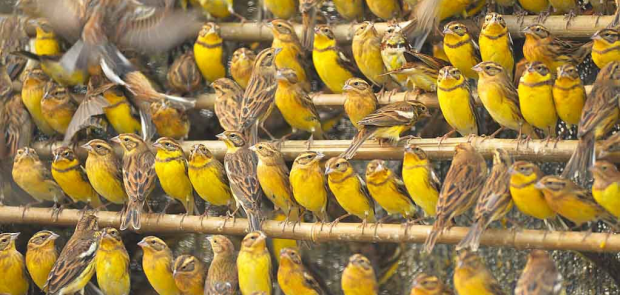Hunted in China, once abundant bird species could be wiped out like passenger pigeons

Massive hunting, mostly in China, has driven populations of a bird species down by 90% and has shrunk their range drastically.
The yellow-breasted bunting, called the rice bird in China, was once Eurasia's most abundant bird species with a range stretching from Finland to Japan.
The unsustainable rate of hunting has retracted its range by 5000kms since 1980 a new study shows. It could well end up wiped out like the passenger pigeons, which were hunted out early last century.
"The magnitude and speed of the decline is unprecedented among birds distributed over such a large area, with the exception of the Passenger Pigeon, which went extinct in 1914 due to industrial-scale hunting", said Dr Johannes Kamp from the University of Münster, the lead author of the paper. "High levels of hunting also appear to be responsible for the declines we are seeing in Yellow-breasted Bunting."
The birds breed north of the Himalayas and spend their winters in warmer southeast Asia, passing through eastern China where they have been hunted for more than 2,000 years, according to BirdLife International.
The songbird, which nests on the ground in open scrubs, is distinctive in its yellow underparts.
During migration and on the wintering grounds, they gather in huge flocks at night making it easy for hunters to trap them in large numbers.
The bird, which was of "least concern" until 2004, was classified in 2013 by the International Union for the Conservation of Nature as an "endangered" species.
Hunting of the species was banned in China since 1997 but millions of yellow-breasted buntings and other songbirds continue to be killed for meat and sold in the black market as seen a couple of years ago.
Once restricted to a small area of southern China, hunting of the bird has now become more widespread and popular owing to increasing affluence, and hunters now travel widely to find sufficient birds, according to IUCN.
Rather than the poor it is the wealthy who are feasting on the rice bird. "They have become a fancy dish among comparatively wealthy people," the researchers said.
The Convention on Migratory Species has agreed to develop an international action plan for the recovery of the yellow-breasted bunting throughout its range by 2017.
"To reverse these declines we need to better educate people of the consequences of eating wildlife. We also need a better and more efficient reporting system for law enforcement", said Simba Chan, senior conservation officer at BirdLife International. Chan believes that growing numbers of birdwatchers in China can be enlisted to curb the hunting.
Published in the journal Conservation Biology the study suggests that the story of the yellow-breasted bunting is evidence of wider problems for common Asian birds, calling for more studies.
However, a new agreement between China, Japan, Republic of Korea and Russia is a first step in developing a coordinated monitoring of migratory birds across the region.
The yellow-breasted bunting Emberiza aureola species has all but disappeared from Eastern Europe, European Russia, large parts of Western and Central Siberia, and Japan.
© Copyright IBTimes 2024. All rights reserved.





















